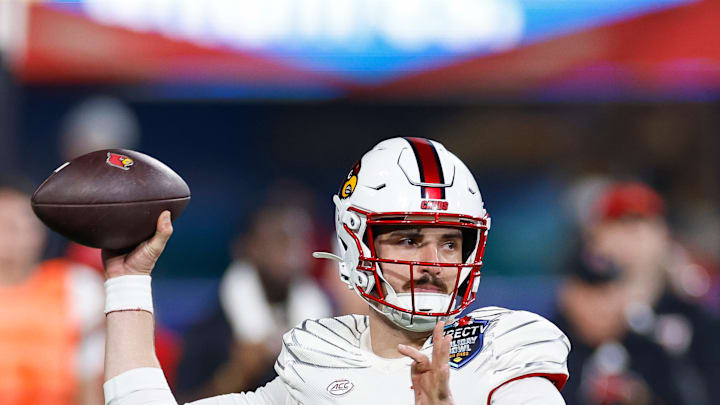THE FBS FOOTBALL CONFERENCES
Big Ten: Michigan, Michigan State, Indiana, Purdue, Illinois, Northwestern, Wisconsin, Minnesota, Iowa, Nebraska, Kansas, Kansas State
— Photo Embeds (@bbpost1111) September 23, 2024
Kansas State grabs the last spot over Iowa State in a conference that goes back to good old fashioned, physical, freezing cold in November midwest football, with some wonderful basketball fanbases. For football talent distribution purposes, Michigan and Ohio State ended up in different leagues, but it doesn't much matter. The Big Ten controls the television contracts for both, so the annual game will still continue on the final weekend of the season.
Eastern Ten: Ohio State, Pitt, Penn State, Rutgers, Maryland, Virginia, Virginia Tech, Duke, North Carolina, North Carolina State, Wake Forest
— Photo Embeds (@bbpost1111) September 23, 2024
Pitt grabs a spot in a league that will run through its north (Ohio State and Penn State) in football, and its south (Tobacco Road schools, UVA and Maryland) in basketball.
Pacific Ten: Washington, Washington State, Oregon, Oregon State, Stanford, California, USC, UCLA, Utah, BYU, Colorado
— Photo Embeds (@bbpost1111) September 23, 2024
BYU and Oregon State have the recent history to earn spots, while Washington State probably should be left out, but we can't eliminate the only flag that can truly unite America in a divisive time. It's a bit different than the original PAC-10, and it's honestly more fun that way.
Southeastern Conference: Alabama, Auburn, Ole Miss, Mississippi State, Tennessee, Vanderbilt, Memphis, Missouri, Arkansas, LSU
— Photo Embeds (@bbpost1111) September 23, 2024
It's never made sense to me how Memphis never got into a power conference, given their recent football quality, longtime basketball success and access to the FedEx fortune. Now, they are in the best conference in football, where the SEC West meets Tennessee and Missouri.
Southwest Conference: Oklahoma, Oklahoma State, Texas, Texas Tech, Texas A&M, SMU, TCU, Baylor, Houston, Arizona, Arizona State
— Photo Embeds (@bbpost1111) September 23, 2024
All of the big Texas schools (including SMU) are finally back together in the 21st century, with their natural duo of rivals in Oklahoma and new blood out west. A lot of tradition and hatred built into these matchups.
South Atlantic Coast Conference: WVU, Kentucky, Louisville, Clemson, South Carolina, Georgia, Georgia Tech, Florida, Florida State, Miami (FL)
— Photo Embeds (@bbpost1111) September 23, 2024
One of these had to get a bit wonky geographically, but the addition of WVU creates a trio of schools on the northern part, separated somewhat from the southern football powerhouses of the SEC East and ACC who will come together more often than Weeks 1 and 13.
Mountain West: All Sports: Boise State, Nevada, UNLV, Fresno State, San Diego State, Air Force, Utah State, New Mexico, Colorado State
Football Only: Hawaii, North Texas, Texas-San Antonio
Non-Football: Gonzaga, Saint Mary's, Grand Canyon
— Photo Embeds (@bbpost1111) September 23, 2024
— Photo Embeds (@bbpost1111) September 23, 2024
Wyoming and San Jose State get the boot and the nine current all sports members are joined by Hawaii, North Texas and UTSA in football and in all other sports by the western basketball powerhouse duo of Gonzaga and Saint Mary's, along with sleeping giant Grand Canyon, a profit generation machine of a university that is investing serious money into basketball.
Eastern Football League: Boston College, Syracuse, Cincinnati, Army, Navy, James Madison, Appalachian State, Central Florida, South Florida, Tulane, Iowa State
— Photo Embeds (@bbpost1111) September 23, 2024
The EFL, which plays for the EFL Cup solely to confuse US-based soccer fans Google and Wikipedia searches, is a one sport only conference, bringing together the best remaining football programs to give a rival league to compete with the Mountain West for an automatic bid to the playoffs.
From here on, all of the remaining schools were split into tiers, based on an informal combination of results in the 21st century (NCAA Tournament appearances/wins, average Kenpom ranking etc.), with an additional emphasis on significant success in the last five years, along with the quality of recent coaching hires and levels of fan interest. Programs clearly making significant financial investments (i.e. McNeese State, James Madison etc.) who have had recent success got a bump up.
Programs currently in the eleven leagues that have been receiving at-large bids over the last decades enjoyed a significant incumbency advantage. It was incredibly tough to get knocked down a tier, with the exception of some of the newer Missouri Valley schools who had no current century success (why did they invite UIC?). Any decent justification for keeping a school up was enough, so congratulations to DePaul on finally making a good coaching hire in Chris Holtmann, and to Duquesne for winning a game in their first NCAA Tournament since 1977.
The conference total was capped at thirty-two (counting the Big Ten and SEC as three each), in order to keep the current at-large/automatic bid split the same. That means that a few dozen schools were left to become independents or head down to Division II. Three hundred and sixty-three schools were too many anyways.
